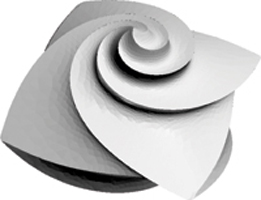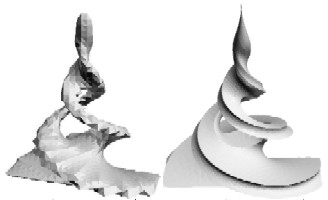Sharp Features of Polygonized Implicit Surfaces


Ohtake Y., Belyaev A., Pasko A.,
Dynamic Mesh Optimization for Polygonized Implicit Surfaces with Sharp Features,
The Visual Computer, vol. 19, No. 2-3, 2003, pp. 115-126.
Electronic version: zipped PDF (1.24 Mb) , PDF (5.2 Mb)
Abstract
The paper presents a novel approach to accurate polygonization of implicit surfaces with sharp features. The approach is based on mesh evolution towards a given implicit surface with simultaneous control of the mesh vertex positions and mesh normals. Given an initial polygonization of an implicit surface, a mesh evolution process initialized by the polygonization is used. The evolving mesh converges to a limit mesh which delivers a high quality approximation of the implicit surface. For analyzing how close the evolving mesh approaches the implicit surface we use two error metrics. The metrics measure deviations of the mesh vertices from the implicit surface and deviations of mesh normals from the normals of the implicit surface.

Ohtake Y., Belyaev A.,
Dual/Primal Mesh Optimization for Polygonized Implicit Surfaces,
ACM Solid Modeling Symposium (June 17-21, 2002, Saarbrucken, Germany), ACM Press, K. Lee and N. Patrikalakis (Eds.), 2002, pp. 171-178.
Electronic version: PDF (1.5 Mb)
Abstract
A new method for improving polygonizations of implicit surfaces with sharp features is proposed. The method is based on the observation that, given an implicit surface with sharp features, a triangle mesh whose triangles are tangent to the implicit surface at certain inner triangle points gives a better approximation of the implicit surface than the standard marching cubes mesh. First, given an initial triangle mesh, its dual mesh composed of the triangle centroids is considered. Then the dual mesh is modified such that its vertices are placed on the implicit surface and the mesh dual to the modified dual mesh is considered. Finally the vertex positions of that “double dual” mesh are optimized by minimizing a quadratic energy measuring a deviation of the mesh normals from the implicit surface normals computed at the vertices of the modified dual mesh. In order to achieve an accurate approximation of fine surface features, these basic steps are combined with adaptive mesh subdivision and curvature-weighted vertex resampling. The proposed method outperforms approaches based on the mesh evolution paradigm in speed and accuracy.
